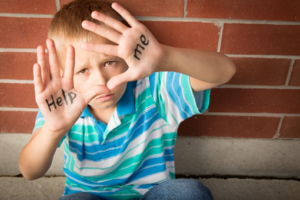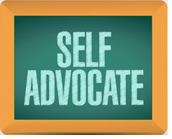Related Products
For Professionals
- Amplification
- Assessment of Student Skills, Challenges, Needs
- Early Childhood: Infants, Toddlers, Preschool
- Hearing Loss – Identification, Impact and Next Steps
- IDEA Law Summary Information
- Language and Speech Development Issues
- Legal Issues in Serving Children with Hearing Loss
- Listening (Auditory Skills) Development
- Planning to Meet Student Needs
- Self-Advocacy Skills for Students with Hearing Loss
- Self-Concept: How the Child with Hearing Loss Sees Himself
- Social Skills
- Speech Perception & Learning
Related Teacher Tools Takeout Items
My student is being bullied but the school isn’t taking it seriously!
Students with hearing loss often struggle in social situations due to a variety of situations. They may not have the level of language sophistication as their peers. They may mis-hear or misunderstand, or they may have a lack of access to what is being said by their peers. All of these can lead to bullying and teasing by peers including systemic bullying. It is critical that the school administration and staff understand your concerns.
As with the greater population of students, our students with hearing loss may be bullied in a variety of ways and circumstances. However, there are built in conditions that can make them feel singled out and isolated even when there is no bullying. If there is bullying on top of this, we must address it and help non-DHH professionals understand the needs of our students.
Real-Life Examples
Playground bullying situation:
My daughter was the first mainstreamed DHH student in our neighborhood school when she was in 2nd grade. Unfortunately, due to the need for CI revision surgery she started the school year in the general education class completely “off the air.” Early on in the school year she found herself being bullied by a group of boys on the playground. My 8-year-old daughter who could not hear anything at the time ended up surrounded by a group of boys taller than her, pushing her, saying things to her that she did not hear. The image of my little girl in that position is still paralyzing.
“Mean girl” bullying situation:
These students of mine are fully mainstreamed and have the benefit of not being the only student in their classes with hearing loss. Unfortunately, they told me at the beginning of 8th grade that all of 7th grade they were teased and humiliated by the “popular” students. They shared that when teachers were syncing their classroom equipment, students would make derogatory comments about their hearing loss that their teachers never heard. Additionally, in Physical Education class the “popular” students would take the teacher mic, walk away, and give commands into the mic like, “turn in a circle,” and “jump up and down.” The students felt like they were treated like pets. When asked why they didn’t say anything to an adult, they shared that they were afraid that if they stood up for themselves, they would not be liked. None of this is actually the case, but that is how our students feel.
 Classroom bullying situation:
Classroom bullying situation:
This student was mainstreamed starting in Kindergarten. Her primary needs focused on self-advocacy. Unfortunately, the year she finally started to advocate for herself she was met with such push back that she ended up in tears at home every night for 2 months. When she advocated for a change of seat due to a peer who caused auditory distraction, her teacher shut her down and told her no. The peer then began to openly bully her and bring the other classmates into it. When she advocated for her accommodations she was told by her teacher that she needed to “do better.”
Deaf plus bullying situation:
This student has a hearing loss as well as physical and medical conditions that limit him. Some of his peers were verbally calling him names related to the fact that he is hard of hearing and also made derogatory comments about his physical condition. Luckily for us, he told his parents and didn’t hold it in. We were able to go to the administration immediately.
Middle school bullying situation:
Back to my daughter…. we had several situations of bullying due to the fact that she was the first oral deaf student and cochlear implant user in our town in the mainstream with no previous path to follow. In 8th grade she had an oral language facilitator assigned to her in order to facilitate communication in the educational setting. This person was and accommodation for her as an oral student the same way a sign language interpreter would facilitate communication for a student who uses ASL. Unfortunately, when the language facilitator left her alone in PE she was physically beat up by 3 boys because she “talked funny.”
What can be done to reduce victimization of students with hearing loss?
 The first step is to inform and involve the parents, if they are not already aware. Every school now has clear policies about bullying. Find the bullying policy and be clear about how the student’s situation fits the definition of bullying per the school policy and the prevention and cessation practices already delineated. Once the administration clearly understands that a true bullying situation is occurring, try to increase their understanding of the extra vulnerability of students with hearing loss and the need to go above and beyond the action items spelled out in policy to truly address victimization of students who are deaf or hard of hearing. These activities can include:
The first step is to inform and involve the parents, if they are not already aware. Every school now has clear policies about bullying. Find the bullying policy and be clear about how the student’s situation fits the definition of bullying per the school policy and the prevention and cessation practices already delineated. Once the administration clearly understands that a true bullying situation is occurring, try to increase their understanding of the extra vulnerability of students with hearing loss and the need to go above and beyond the action items spelled out in policy to truly address victimization of students who are deaf or hard of hearing. These activities can include:
- Peer in-services: Proactively, the best way to create a circle of support around our students is to do peer in-services at the beginning of each year. I like to explain how amazing their peer with hearing loss is as a person dealing with a challenge. Answer all of the peer’s questions to take the mystery out of it, and at the same time give the peers a sense of ownership in understanding that in noisy situations when there is not teacher using an FM/DM system, their friend is going to have a harder time hearing. Make the inservice age appropriate and new every year. The requirement for peer inservice can be added into the IEP as an accommodation.
- Grade level in-services: Some schools will do grade level presentations either directly related to the student with hearing loss and their unique circumstance or more of a focus on tolerance, empathy, and understanding differences. Kids are amazing!! They will almost always recognize that we all have something that makes us feel different and this helps to promote empathy for our students with hearing loss as well as for all of their peers.
- Intervention in the moment: If there is bullying in the moment, pull the 2 students together and ask the student with hearing loss what they heard. This gives you the opportunity to work on communication repair and at the same time you are able to teach the typically hearing peer about how they may have been misunderstood or not heard at all. You can respond to the cause of bullying in the moment without ever directly addressing the typical peer.
- Staff training: Talk with the school administration about the nuances of how hearing loss, listening in noise, and language issues can affect our students in social communication. You may want to ask for an opportunity to speak at a regularly scheduled staff meeting. This way you will be able to address the general education teachers as a group and get them on board with addressing bullying of students and add a focus on hearing loss specifically.
- DHH Itinerant push-in services: If the teacher of the deaf/hard of hearing is currently only providing pull-put services, adding some push-in services in order to observe in class can lead to opportunities for intervention. Observe during regular instruction, specialist instruction (ie: Art, Music, etc.), and during unstructured times (i.e., PE, recess, lunch, etc.).
 Goals for communication repair and self-advocacy: As this month’s Update topic emphasizes, about a quarter of typically hearing students are victimized whereas over half of students with hearing loss typically experience some type of bullying. While being bullied is not the fault of the student with hearing loss, you can prepare them to deal with the likelihood of being victimized by adding goals for communication repair strategies and self-advocacy. This way you can work directly with your student on how to handle situations in which they are being bullied.
Goals for communication repair and self-advocacy: As this month’s Update topic emphasizes, about a quarter of typically hearing students are victimized whereas over half of students with hearing loss typically experience some type of bullying. While being bullied is not the fault of the student with hearing loss, you can prepare them to deal with the likelihood of being victimized by adding goals for communication repair strategies and self-advocacy. This way you can work directly with your student on how to handle situations in which they are being bullied.

Author: Melinda Gillinger, M.A., Special Education Consultant
Click here to download this article
